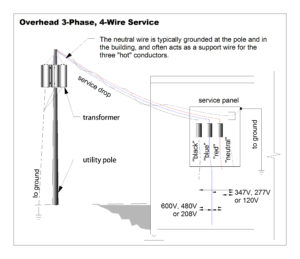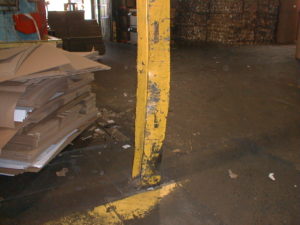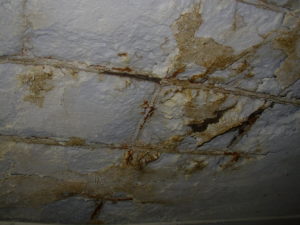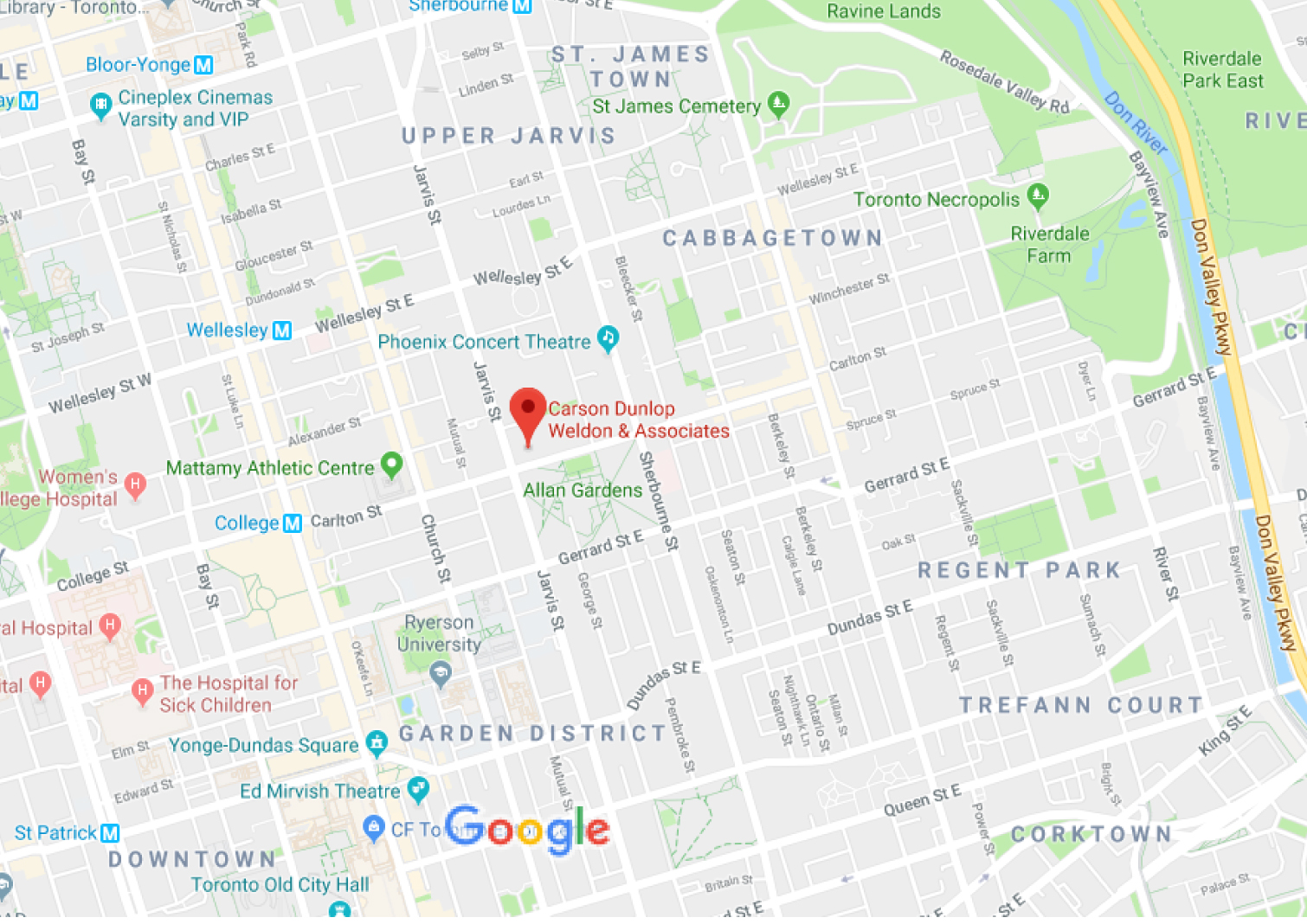Due Diligence – Building Deficiency Top Ten List
- Feb 07, 2013
- By Tracy Gaudet
- In Resource Center
No building is perfect. The question is how imperfect is it? What sort of yardstick do we use to measure the condition of buildings, and at what point in time do we bring out these yardsticks to measure the condition of the building?
Following is a top ten list of common deficiencies found in low-rise industrial/office buildings during the due diligence period.
Low-Rise Buildings
10. Floor Slabs on Grade Cracking and Settling
The Problem
- All concrete slabs-on-grade shrink and then will likely crack.
- The floor slab will also settle if there was improper sub grade preparation.
- Settlement is likely to occur are where excavation was undertaken –
near the perimeter footings or along the column lines.
The Remedy
- Minor crack repairs can be easily undertaken by routing the crack first
and applying an epoxy or urethane sealant. - Cost is typically $20.00 per linear foot.
- More extensive slab settlement may require localized slab replacement.
This may require proper compaction of fill material. - The cost of this repair is in the order of $15.00 to $20.00 per square foot.
In order to prevent cracks from occurring in the first place it is common to provide control joints
in the slab. Control joints are saw cuts made in the concrete to control where cracking occurs.
9. Incorrect Listing of Building Electrical Service Size
The Problem
- Not knowing how to determine the correct electrical service size.
- Listing the incorrect service size is a liability.
The Remedy
- Don’t list the service size unless you are aware of exactly what it is.
- To greatly reduce your liability, hire a company that performs property condition assessments to undertake an assessment prior to listing the building for sale.
- Recognize when power requirements are important to your clients needs.
- The following four items are important to know to correctly size the service:
1. Main building transformer size – this may require contacting the utility provider.
2. Size of cables feeding power to the building.
3. Size of fuses or main interrupter in main disconnect switch at building.
4. Ratings of main disconnect switch and main switchgear.
8. Impact Damaged Steel Structures and Missing Steel Bracing
The Problem
- Forklift operators who think that they are racecar drivers.
- Steel bracing not originally installed or removed during building modifications.
The Remedy
- Repairing damaged columns or replacing missing bracing is typically not expensive. If column impact damage is relatively minor, and not located near the mid-point of the column, repairs are often less than $1,000.
- If the damage is substantial or near the center of the column, buckling is a concern and partial or complete replacement of the column may be necessary. This would generally be a $5,000 to $10,000 repair.
- If bracing has been removed to facilitate a new overhead door or other feature it will be necessary to reinforce the structure. This would require the expertise of a structural engineer, and depending upon the modification required, a $5,000 to $10,000 figure
may be encountered.
7. Damaged Walls
The Problem
- The same forklift operators will also hit walls.
- Truck drivers backing into loading docks want their turn as well.
The Remedy
- Impact damaged walls will require repair or replacement.
- Provide dock cushions around loading docks where impact is likely to occur.
- This is generally considered a maintenance issue and does not require major expenditures as a priority.
6. Older HVAC Equipment – Low-Rise
The Problem
- Heating, ventilation and air-conditioning equipment does not last forever. Unfortunately, a well-maintained building can become an issue based on age of equipment alone.
- Some building environments will reduce HVAC equipment life expectancies.
For example, in colder climates, warehouse heaters located close to overhead doors won’t last as long because of the thermal stresses encountered when the doors are opened in the wintertime. Some processes in buildings, such as metal plating or any high humidity will cause premature corrosion of HVAC equipment.
The Remedy
- For package rooftop heating and cooling units, individual components, such as heat exchangers or compressors, can be replaced for a cost of roughly $2,000 to $5,000 to replace. Similarly, the heat exchanger at a warehouse-heating unit could also be replaced for $1,000 to $2,000.
- Alternatively, unit replacement may prove necessary. This would be the case if replacement parts were not available. Entire package unit replacement would be in the order of $2,000 per ton of cooling.
- With rooftop units, if both the heat exchanger and compressors were more than 15 to 20 years old, than it would be more cost effective to replace the entire unit rather than the major components within.
5. Older Asphalt Paving
The Problem
- Asphalt paving does not last forever.
- Depending upon the use of the building, and the location of the asphalt, accelerated wear can be encountered. Accelerated wear will occur where trucks, in particular, turn. This includes at the corners of the building, and in front of the loading dock areas.
- Although, there are commonly two types of asphalt paving installed at most industrial properties, it is not possible to visually identify the types after they are installed.
- Heavy-duty asphalt paving is a common term for that installed where trucks are expected to travel; light duty asphalt paving is typically installed where passenger vehicles will travel and park. The difference between the two is largely in the thickness of the granular base
and the thickness of the layers of asphalt installed, as well as the number of layers of asphalt installed. - Premature surface deterioration is typically the result of an inadequate granular base or thickness of asphalt applied. The implication of asphalt deterioration for a 5-year-old installation is very
different than that for a 25-year-old installation. In the former, it will likely be necessary to undertake excavation and provide a better sub-strate. In the latter, renewing the top course of asphalt only may be sufficient.
The Remedy
- Any large areas of cracking in asphalt paving should be sealed to minimize further deterioration.
- Localized depressions in asphalt paving (particularly around catch basins where the asphalt
will settle relative to a concrete structure) should be repaired. The cost for this can be
in the neighborhood of $3.00 to $5.00 per square foot. - Complete renewal of asphalt paving is required for significant deterioration. Depending upon
whether or not significant sub-strate improvements are required, the cost will vary significantly
from $1.50 to $4.00 per square foot.
4. Roofs – Low-Rise
The Problem
- There are many here. Generally, old age, poor workmanship, out-of-sight out-of-mind attitude, and in particular, phenolic foam insulation are common concerns.
- The bottom line is: expect to find a need for repairs on every roof.
- Phenolic foam insulation was manufactured in United States from 1980 to 1992; in Canada from the mid 1970’s to 1994. The concern with this insulation is that if it becomes wet it will corrode steel. Therefore, when installed on top of a steel roof structure there is great concern.
The Remedy
- Make repairs to the roof as necessary. Roofs should be inspected and repaired at least annually.
- If repairing is not considered cost effective than replacement is necessary.
- When replacing, it is always advisable to remove the existing material prior to installing a new membrane. If a new membrane is installed on top of an older system and water becomes trapped within the assembly, the life expectancy of the newer system would be greatly reduced. The cost to remove an existing roof membrane and install a newer membrane for a low-rise building is in the $7.00 to $11.00 per square foot range. Here are some things to consider:
-
- Know by the age of the building and the roof deck type if phenolic foam insulation could be a concern.
- On larger roofs, consider staged roof replacement, as opposed to entire roof replacement at one time.
High-Rise Buildings
3. Old HVAC Equipment – High-Rise
The Problem
- The HVAC equipment won’t last forever.
- High-rise HVAC equipment is more complicated and expensive to update.
- Access to replace equipment can be severely limited.
- There are also sophisticated control and refrigerant considerations due to technological and environmental changes.
The Remedy
- The considerations for updating or replacing HVAC equipment in high-rise buildings include:
-
- The option of rebuilding equipment versus replacing.
- The life cycle of the equipment.
- The life cycle and future use of the building.
- The phase out of certain refrigerant types.
- Very often further detailed analysis would be required. A property condition assessment can typically not go into the necessary detail to make a firm recommendation in this respect.
- Generally, HVAC updates can be spread out over a period of time.
2. Deteriorated Caulking on Face Seal Cladding Systems
The Problem
- Some exterior wall cladding systems rely solely on the exterior sealants to keep water out. As a refresher, a face seal system is a cladding system that employs a water-tight outer face. This system does not rely on a cavity space, drainage plane, or weep holes for keeping water out of the wall assembly.
- It is difficult to install sealants perfectly.
- Even if installed perfectly, sealants will eventually fail and allow leakage to occur.
The Remedy
- Replace sealants as necessary. Depending upon accessibility, the cost of this can range from $2.00 to $5.00 per linear foot.
- Recognize most sealants last only 10 to 20 years.
- Buildings over three storeys in height may have special requirements for roof anchors to allow such exterior facade maintenance to occur.
1. Parking Garage Deterioration
The Problem
- Water, and in particular salt in water, collecting on suspended concrete floor slabs.
- If the water reaches the reinforcing steel within the concrete, the steel will corrode. As steel corrodes it expands significantly and will cause cracking in the concrete. This condition will then accelerate.
- Every building with a multi level parking garage structure or parking garage structures that extend beyond the footprint of the building are susceptible.
- This is of greater concern if the floor slab is a pre-stressed (either pre-tensioned or post-tensioned)
The Remedy
- During a visual assessment, some of the indicators can be identified, but typically a detailed review is required to assess the extent of repairs required. Localized concrete repairs can cost $20.00 to $50.00 per square foot. (Less expensive if repairing the top side of the slab
and more expensive if repairing the underside of the slab). - In areas where deicing salts are used on the roads, consideration should be given to providing a protective surface membrane for the slab. The cost of the installation of such a membrane is $3.00 to $5.00 per square foot.
- It is important to recognize the difference between conventionally reinforced concrete and pre-stressed concrete. The implication of cracking and potential for deterioration is significantly different between the two reinforcement types.
Dealing With The Issues
We have discussed the ten most common problems that can be found in low-rise industrial/office
and high-rise office buildings. We recognize that no building is perfect, and generally buildings
that are 15-years-old or older are more likely to require some form of repair or replacement
in the foreseeable future.
As such, it is important to align a purchaser’s expectations of the building. It is important to stress that there is no such thing as a perfect building. Even assessments of brand new buildings will find deficiencies that require repair.
When working on behalf of a purchaser, ask the current owner for documentation of any repairs or updates. The implication of someone suggesting there is a “new” roof on the building can be very different. Back it up with an actual receipt or invoice.
Recognize the building age. Apart from the obvious damage which can occur to any building, expect to update:
- HVAC systems, sealants and asphalt after 15 to 20 years.
- Roof membranes and parking garage rehabilitation after 20 to 30 years.
Inspect Before You Sell
What if every building that went on the market had a Phase I Environmental Site Assessment and a Property Condition Assessment done before it went on the market? Would this not simplify the process? Some of the benefits of such an approach include:
- Align the current owner’s expectations of the property value.
- This is the ultimate form of disclosure
- Allow the owner to undertake repairs as deemed necessary.
- Eliminate the 11th hour price negotiation based on new information from a purchaser’s report.
- A short due diligence period would be required if this work was already carried out. This would speed up the transaction.
- By hiring a reputable firm to do the report up front, there will be less problems with reports from others who may be less qualified.
- Provide accurate listing information which would reduce liability, as well as minimize erosion of creditability by providing misinformation.
- Less opportunity for others who are looking to acquire further remediation, investigation, design or project management work based on the findings in the initial property condition assessment.
I once had a client from Europe, who was looking at buying an office building, ask me about the process. Even when I assured him that I was the wrong person to ask about the process, I found his questions quite interesting. You mean you expect me to submit an offer to purchase
this building before I have the property condition assessment done? How do I know how much money to offer for the property if I don’t know its condition?






